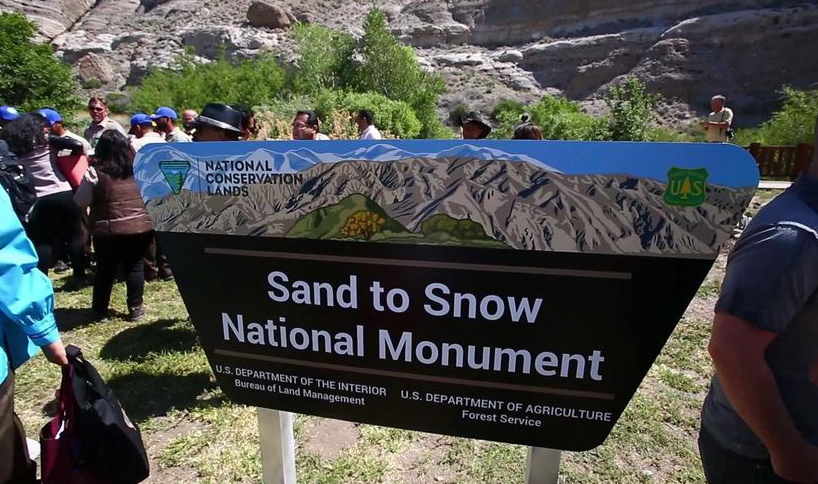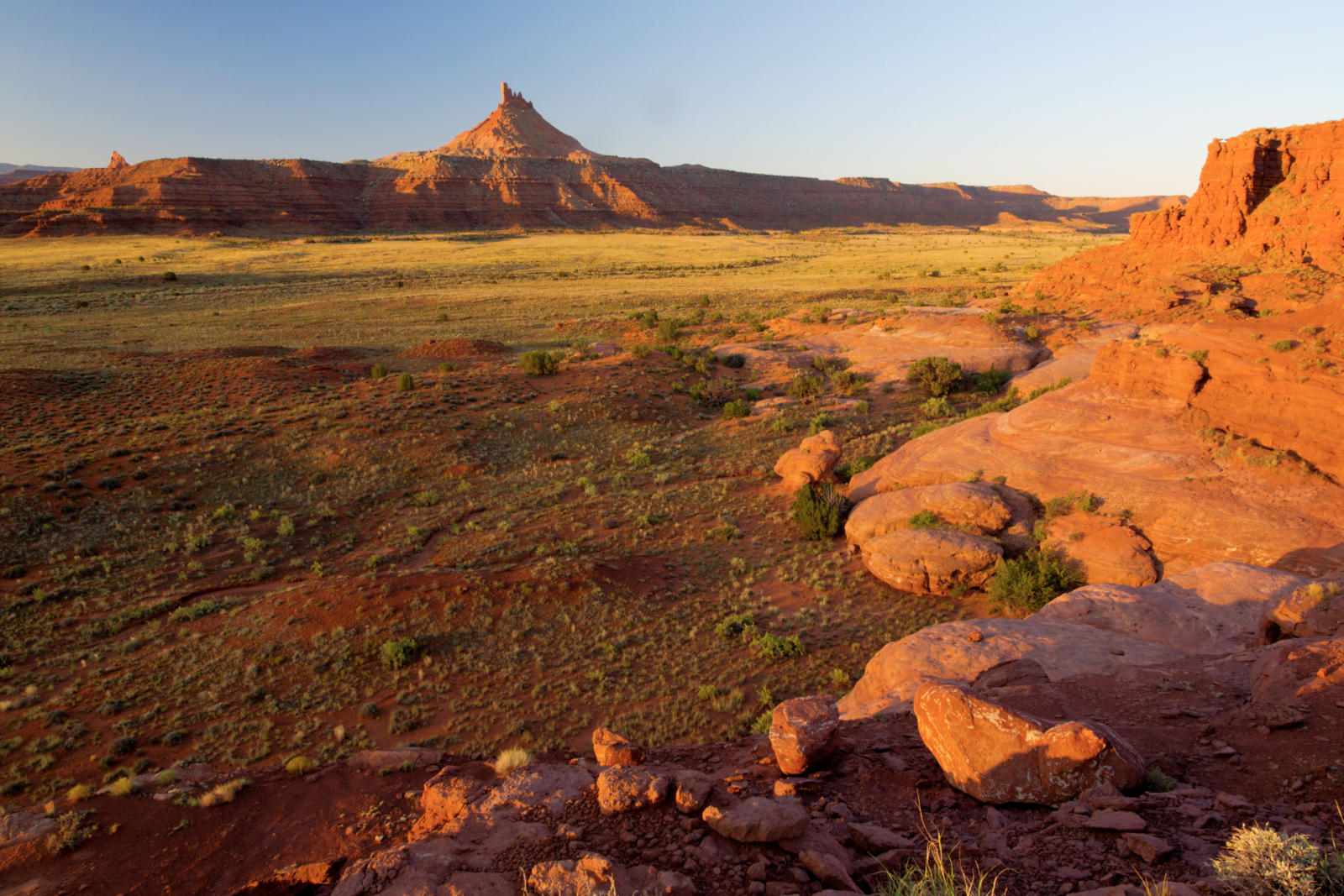Throwing all environmental law and conservation policy norms out the window, President Trump signed an executive order on Wednesday directing the Interior Department to conduct a “review” of the establishment of all National Monuments going back to 1996, with the clear intent of undoing or shrinking some or all of these federally-protected areas.
As we’ve been expecting, it is the most full-fledged, naked assault on conservation policy in modern U.S. history, and another attempt by the GOP to ultimately privatize public land that belongs to you and I. The established National Monuments being subjected to “review” include:
- Grand Staircase-Escalante, Utah (1996)
- Grand Canyon-Parashant, Arizona (2000)
- California Coast, California (2000, exp. 2016)
- Giant Sequoia, California (2000)
- Canyon of the Ancients, Colorado (2000)
- Cascade-Siskiyou, California and Oregon (2000, exp. 2017)
- Hanford Reach, Washington (2000)
- Ironwood Forest, Arizona (2000)
- Santa Rosa and San Jacinto Mountains, California (2000)
- Vermillion Cliffs, Arizona (2000)
- Carrizo Plain, California (2001)
- Sonoran Desert, Arizona (2001)
- Upper Missouri River Breaks, Missouri (2001)
- Papahānaumokuākea, Midway Atoll (2006)
- Marianas Trench, Mariana Islands (2009)
- Rose Atoll, Samoa (2009)
- Pacific Remote Islands, Hawaii (2009)
- Rio Grande del Norte, New Mexico (2013)
- Organ Mountains-Desert Peaks, New Mexico (2014)
- San Gabriel Mountains, California (2014)
- Berryessa Snow Mountain, California (2015)
- Basin and Range, Nevada (2015)
- Mojave Trails, California (2016)
- Sand to Snow, California (2016)
- Northeast Canyons and Seamounts, Georges Bank (2016)
- Bear Ears, Utah (2016)
- Gold Butte, Nevada (2016)
As if Donald Trump hasn’t already done enough to ensure his place as the most anti-environmental, anti-conservation president in U.S. history, all within a matter of weeks, he’s now seeing fit to appease the Cliven Bundy fringe of Republican party extremism – the most reactionary wing of his constituency. Meanwhile, where are the Democrats?
Almost all of the National Monuments listed above came together according to the guidelines set down by the landmark Antiquities Act of 1906. Signed into law by President Theodore Roosevelt, one of our nation’s greatest conservationists, the Antiquities Act is one of the most powerful pieces of policymaking available to the President of the United States. Along with preserving dozens of other sites under the policy, President Roosevelt used the Antiquities Act to preserve what is now Grand Canyon National Park in Arizona and Olympic National Park in Washington as National Monuments in 1908 and 1909, respectively.
Theodore Roosevelt also established Pinnacles National Monument here in California in 1908, which became a National Park in 2013. Death Valley and Joshua Tree were both established as National Monuments by President Franklin Roosevelt in 1933 and 1936, and both became National Parks in 1994 with the passage of the California Desert Protection Act, which also established Mojave National Preserve.
While National Monuments can be passed as legislation by Congress in the same manner as a National Park, the Antiquities Act gives the president the ability to immediately designate an area of federal land as a National Monument with the stroke of a pen. The idea is to quickly protect any area that may be threatened, or designate an area of importance if Congress is moving too slow on National Park or Wilderness legislation, or if Congress shows little interest in advancing a conservation option for the area at all.
While Cabrillo National Monument in San Diego won’t be affected by the Interior Department review (it was established by President Woodrow Wilson in 1913), it’s no accident the National Monuments called into question by the Trump executive order stretch back to 1996, the year President Bill Clinton protected what is now Grand Staircase-Escalante National Monument, which lies adjacent to Bryce National Park in Utah. The “cutoff” date on the executive order is a clear indication of the lobbying and influence of far-right and anti-conservation groups within the Trump administration and western counties in Utah, Nevada and elsewhere.
As today’s Republican-controlled Congress moves further to the right and away from the political center of the American mainstream, conservation initiatives and protecting clean air, water, wildlife habitat, open space and our country’s natural heritage have become another matter of kneejerk partisanship for Republicans – even in districts where many of our nation’s natural wonders can be found, despite the fact many of those monuments have become economic engines by way of eco-tourism and park visitation.
In his remarks, President Trump specifically referred to Bear Ears National Monument in Utah, which was established as a National Monument by President Obama in December. Located along the borders of Canyonlands National Park and Glen Canyon National Recreation Area, Bear Ears also surrounds Natural Bridges National Monument, and had been the subject of a lengthy, grassroots effort to protect its sage and oak woodland habitat going back to the 1980s, as well as areas within the monument sacred to the Navajo, Hopi, Ute, Uintah, Ouray and Pueblo people.
Trump referred to the Bear Ears designation as a “land grab,” parroting earlier and equally absurd charges made by anti-conservation extremists. It’s anything but a land grab – and demonstrates the president’s complete ignorance on the subject. Bear Ears has been managed by the federal government as public land since Utah was a territory. Declaring Bear Ears to be a “land grab” implies that the land was sitting around with no owner, or was seized (!) as part of the Obama designation in December.
While Trump probably doesn’t know better, those who make the “land grab” charge are yelling fire in a crowded theater in a manner to incite fools like the Bundy clan, who conducted an armed seizure of the Malheur National Wildlife Refuge in Harney County, Oregon, in late 2015, citing the “tyranny” of federal land control – apparently without noticing the Malheur has been a National Wildlife Refuge since 1908 (!) and is a center of jobs and economic activity for Harney County. Some tyranny.
Any and all land designated as National Monuments are already on federal land, there’s no practice of seizing or taking land from others – unlike the kind of eminent domain laws Mr. Trump benefits from in order to build his buildings. The only thing that changes with the National Monument designation is the understanding that the area will be managed for long-term conservation, not for short-term gain. It is to be managed for all Americans to enjoy and revel in, not for a few to profit from at the expense of habitats and our environment. As a result, use of recreational machines may be curtailed and resource extraction may no longer be allowed, but hiking and hunting are prime activities.
The likelihood that the executive order’s Interior Department “review” will ever lead to the undoing of an actual National Monument is dubious, as is the chance that it would survive any kind of court challenge, but it is the beginning of a larger assault on our public lands. Even though the Antiquities Act is 111 years old and has been used by over a dozen administrations to protect cultural or environmentally-valuable areas, no president has ever tried to undo a National Monument that was established by a previous administration or an Act of Congress. It’s unheard of.
Typically a National Monument is managed by the National Park Service, which falls under the auspices of the Department of the Interior. However, since 1980, it has become more common for the U.S. Forest Service and the Bureau of Land Management (BLM) to manage areas designated as National Monuments. The new(er) Sand to Snow and Mojave Trails National Monuments in California are good examples of monuments managed by the BLM.
This is a developing story, so please check back.

Bears Ears National Monument and Sand to Snow National Monument sign photos by Bob Wick, Bureau of Land Management (BLM)

